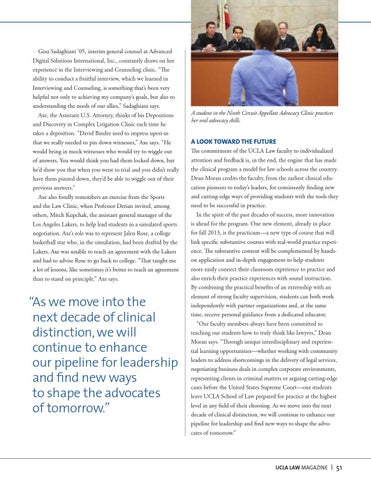Gisu Sadaghiani ’05, interim general counsel at Advanced Digital Solutions International, Inc., constantly draws on her experience in the Interviewing and Counseling clinic. “The ability to conduct a fruitful interview, which we learned in Interviewing and Counseling, is something that’s been very helpful not only to achieving my company’s goals, but also to understanding the needs of our allies,” Sadaghiani says. Axe, the Assistant U.S. Attorney, thinks of his Depositions and Discovery in Complex Litigation Clinic each time he takes a deposition. “David Binder used to impress upon us that we really needed to pin down witnesses,” Axe says. “He would bring in mock witnesses who would try to wiggle out of answers. You would think you had them locked down, but he’d show you that when you went to trial and you didn’t really have them pinned down, they’d be able to wiggle out of their previous answers.” Axe also fondly remembers an exercise from the Sports and the Law Clinic, when Professor Derian invited, among others, Mitch Kupchak, the assistant general manager of the Los Angeles Lakers, to help lead students in a simulated sports negotiation. Axe’s role was to represent Jalen Rose, a college basketball star who, in the simulation, had been drafted by the Lakers. Axe was unable to reach an agreement with the Lakers and had to advise Rose to go back to college. “That taught me a lot of lessons, like sometimes it’s better to reach an agreement than to stand on principle,” Axe says.
“As we move into the next decade of clinical distinction, we will continue to enhance our pipeline for leadership and find new ways to shape the advocates of tomorrow.”
A student in the Ninth Circuit Appellate Advocacy Clinic practices her oral advocacy skills.
A look ToWArd ThE fuTurE The commitment of the UCLA Law faculty to individualized attention and feedback is, in the end, the engine that has made the clinical program a model for law schools across the country. Dean Moran credits the faculty, from the earliest clinical education pioneers to today’s leaders, for consistently finding new and cutting-edge ways of providing students with the tools they need to be successful in practice. In the spirit of the past decades of success, more innovation is ahead for the program. One new element, already in place for fall 2013, is the practicum—a new type of course that will link specific substantive courses with real-world practice experience. The substantive content will be complemented by handson application and in-depth engagement to help students more easily connect their classroom experience to practice and also enrich their practice experiences with sound instruction. By combining the practical benefits of an externship with an element of strong faculty supervision, students can both work independently with partner organizations and, at the same time, receive personal guidance from a dedicated educator. “Our faculty members always have been committed to teaching our students how to truly think like lawyers,” Dean Moran says. “Through unique interdisciplinary and experiential learning opportunities—whether working with community leaders to address shortcomings in the delivery of legal services, negotiating business deals in complex corporate environments, representing clients in criminal matters or arguing cutting-edge cases before the United States Supreme Court—our students leave UCLA School of Law prepared for practice at the highest level in any field of their choosing. As we move into the next decade of clinical distinction, we will continue to enhance our pipeline for leadership and find new ways to shape the advocates of tomorrow.”
UCLA LAW MAGAZINE |
219405_Text_r1.indd 51
51
9/12/2013 1:07:52 PM
